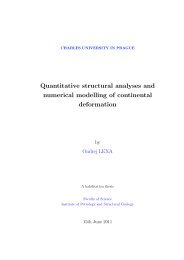The causal link between HP–HT metamorphism and ultrapotassic ...
The causal link between HP–HT metamorphism and ultrapotassic ...
The causal link between HP–HT metamorphism and ultrapotassic ...
Create successful ePaper yourself
Turn your PDF publications into a flip-book with our unique Google optimized e-Paper software.
78<br />
Unit are the U–Pb zircon age from rare K-rich granulites<br />
of the Blanský les Massif (Fig. 1b) of 338�1Ma<br />
(Aftalion et al., 1989) <strong>and</strong> a mean 339.8�2.6 Ma<br />
of SHRIMP ages for multifaceted zircon grains in<br />
ordinary South Bohemian granulites (Kröner et al.,<br />
2000). Numerous other U–Pb zircon <strong>and</strong> monazite<br />
ages clustering around 340 Ma have also been interpreted<br />
as reflecting the peak metamorphic crystallization<br />
by most of the authors. Apart from those<br />
presented in Figure 3, this also concerns U–Pb zircon<br />
ages from granulite clasts in the Late Viséan conglomerates<br />
(molasse) from Central Moravia (Kotková<br />
et al., 2003a).<br />
In contrast, Roberts & Finger (1997) claimed that<br />
much of the zircon would have crystallized from<br />
partial melts, which would have persisted throughout<br />
much of the metamorphic history. Saturation with<br />
zircon would only occur on the retrogressive path, with<br />
the zircon growth therefore largely post-dating the<br />
HP metamorphic climax. Also Prince et al. (2000)<br />
assumed, based on a Sm–Nd age for garnet cores with<br />
prograde zoning (354�6 Ma), that the <strong>HP–HT</strong> metamorphic<br />
peak could have been somewhat older. However,<br />
such scenarios would contradict the fact that<br />
many of the analysed zircons were enclosed in garnet<br />
or antiperthite (former ternary feldspar), the <strong>HP–HT</strong><br />
metamorphic phases (Aftalion et al., 1989; Kröner<br />
et al., 2000). <strong>The</strong>refore, the age of the granulite-facies<br />
<strong>metamorphism</strong> is unlikely to differ substantially from<br />
340 Ma.<br />
V. JANOUŠEK<br />
Fig. 2. Schematic map showing Variscan granitoid complexes (grey) <strong>and</strong> distribution of the highly potassic to <strong>ultrapotassic</strong><br />
plutonic rocks (in black) within the Moldanubian Unit of the Bohemian Massif.<br />
<strong>The</strong> high-grade <strong>metamorphism</strong> in the Gföhl gneiss<br />
in Moravia has been pin-pointed to 341�4Ma<br />
<strong>and</strong> 337�3 Ma (van Breemen et al., 1982). Similarly,<br />
the Gföhl gneiss in Austria has been dated at<br />
340�10 Ma <strong>and</strong> 339.9�0.9 Ma (Friedl et al., 1994;<br />
1998) (Fig. 3).<br />
Protolith of the granulites<br />
<strong>The</strong> spectrum of inherited ages in zircons from the<br />
Moldanubian granulites is characterized by Palaeozoic<br />
age maxima at c. 360 Ma, 400 Ma <strong>and</strong> 450–470 Ma<br />
(Kröner et al., 2000; Friedl et al., 2004 – see Janoušek<br />
et al., 2004b, fig. 2 for a review).<br />
Sm–Nd ages from peridotites <strong>and</strong> eclogites<br />
<strong>The</strong> available results of the Sm–Nd mineral isochron<br />
dating of the peridotites <strong>and</strong> associated HP mafic rocks<br />
from the Gföhl Assemblage have been summarized<br />
by Medaris et al. (2005). <strong>The</strong> garnet peridotites have<br />
generally yielded Viséan cooling ages averaging<br />
339�10 Ma <strong>and</strong> some of the garnet pyroxenite <strong>and</strong><br />
eclogite layers gave a comparable mean Sm–Nd age<br />
of 336�7 Ma. However, several garnet pyroxenite<br />
<strong>and</strong> eclogite samples were dated at c. 370 Ma to<br />
377 Ma.<br />
Emplacement of <strong>ultrapotassic</strong> rocks<br />
<strong>The</strong> tectonic emplacement of the Gföhl Assemblage to<br />
higher crustal levels had to have been finished soon<br />
after the peak of the HP <strong>metamorphism</strong>, because the







